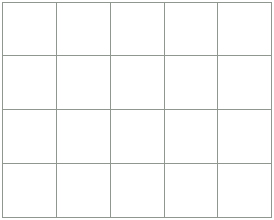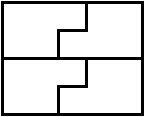Fitting Together II
This task is about tessellating shapes.
Practical task
Colour the four shapes on the last page red, and then cut out.
| a) |
Arrange the four shapes so that they fit exactly on the grid with the red sides facing up.
Then draw around each shape to show where it fits on the grid.
|
 |
| b) |
Arrange the four shapes so that they fit exactly on the grid with the white sides facing up.
Then draw around each shape to show where it fits on the grid.
|
 |
| c) |
Arrange the four shapes so that they fit exactly on the grid.
There must be at least one red side facing up and at least one white side facing up.
Then draw around each shape to show where it fits on the grid.
|
 |
| d) | Arrange the four shapes so that they fit exactly on the grid. There must be at least one red side facing up and at least one white side facing up and you must find a way of arranging the shapes that is different from what you did before. Then draw around each shape to show where it fits on the grid. |
 |
Shapes








